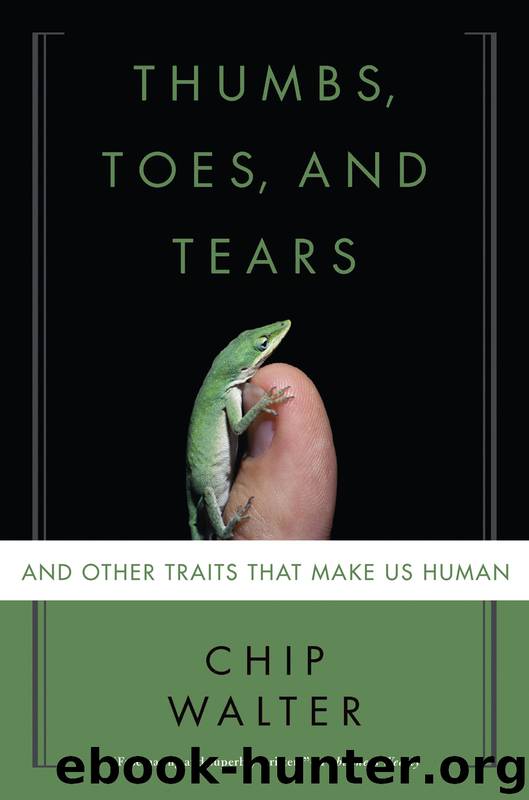Thumbs, Toes, and Tears by Chip Walter

Author:Chip Walter
Language: eng
Format: epub
Publisher: Bloomsbury Publishing Plc
Published: 2006-07-26T16:00:00+00:00
IV
Laughter
Chapter 8
Howls, Hoots, and Calls
Two cannibals are sitting beside a large fire after eating the best meal they have had in ages.
“Your wife sure makes a good roast,” says the one cannibal.
“Yeah,” replies the other, “I’m really going to miss her.”
—Anonymous
Laughter is one of the great Mysteries of human behavior. It evades understanding and resists analysis, partly because it thoroughly combines the primal and the intellectual parts of us. Yet we barely acknowledge what an unusual behavior laughing is, mostly because it is so woven into the woof and weave of our lives. Like the noses on our faces and the lobes of our ears, it’s familiar to the point of invisibility. Yet if it were suddenly plucked out of our existence, we would be lost because we use it constantly to send strange and mysterious signals to one another.
The origins of laughter are ancient and wordless, a behavior whose roots run a good deal deeper than the evolutionary wellsprings of language. It is related to play and feeling good, although it isn’t simply about fun. Darwin observed that it can also show up when we are feeling anger, shame, or nervousness, acting to mask, rather than display, emotion. At other times it may communicate appeasement or submission.1 Or as Dante put it, “He is not always at ease who laughs.”2
The social nature of laughter also makes it contagious. When someone laughs, the rest of us almost always do the same. This is why Charles Douglass, a television technician, invented the laugh track in 1953, and why it is still effectively used today to make some sitcom jokes seem funnier than they actually are.3 It is why, even when we watch total strangers laughing about something we know nothing about, we will involuntarily smile or chuckle.
Maybe this explains laughter’s universality. Everyone laughs, no matter where he lives, no matter what her race or background, whether he hunts corporate heads among the skyscrapers of Manhattan or real ones in the rain forests of Borneo. It sews us together as a species and as people. Along with big toes and thumbs and our oddly designed throats, it is one of those unique traits that distinguish us from the other animals.
Despite its familiarity and universality, we are almost entirely clueless about how we have become the laughing creature. There is no obvious, practical reason for laughing. If evolution resolutely favors the emergence of the eminently practical, what possible purpose could laughter serve? It’s loud and calls attention to us—not necessarily a good thing when avoiding carnivores on the savanna, or hunting mammoths on the tundra. And when we laugh we tend to lose control, as though our minds and bodies have been hijacked, also not a recommended survival technique. Nor is laughing at predators really a very good idea, at least not unless it is done well after the hunt, by a campfire, in a cave far, far away.
In the crucible of evolution, behaviors also tend to become increasingly entwined in the traffic
Download
This site does not store any files on its server. We only index and link to content provided by other sites. Please contact the content providers to delete copyright contents if any and email us, we'll remove relevant links or contents immediately.
Sapiens: A Brief History of Humankind by Yuval Noah Harari(14221)
Sapiens by Yuval Noah Harari(5281)
Pale Blue Dot by Carl Sagan(4886)
Homo Deus: A Brief History of Tomorrow by Yuval Noah Harari(4801)
Livewired by David Eagleman(3663)
Origin Story: A Big History of Everything by David Christian(3632)
Brief Answers to the Big Questions by Stephen Hawking(3358)
Inferior by Angela Saini(3261)
Origin Story by David Christian(3133)
Signature in the Cell: DNA and the Evidence for Intelligent Design by Stephen C. Meyer(3057)
The Gene: An Intimate History by Siddhartha Mukherjee(3030)
The Evolution of Beauty by Richard O. Prum(2926)
Aliens by Jim Al-Khalili(2776)
How The Mind Works by Steven Pinker(2715)
A Short History of Nearly Everything by Bryson Bill(2616)
Sex at Dawn: The Prehistoric Origins of Modern Sexuality by Ryan Christopher(2472)
From Bacteria to Bach and Back by Daniel C. Dennett(2432)
Endless Forms Most Beautiful by Sean B. Carroll(2415)
Who We Are and How We Got Here by David Reich(2387)
